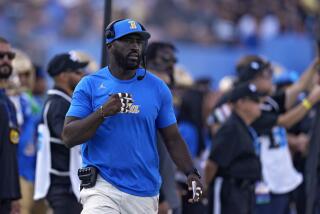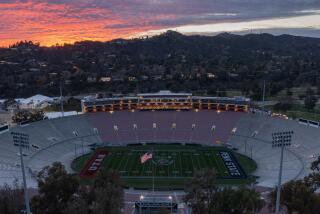The Money Game
Everyone’s fighting over the Fighting Irish.
Never mind all the sports polls and rankings naming the University of Miami as the nation’s top college football team. Anyone planning a bowl game in California this year knows that Notre Dame is No. 1 -- because the real action is in tourism, not football.
To bowl organizers and economic development officials, it’s the players in the grandstands -- rather than the ones on the gridiron -- that matter most.
They want teams from cold weather climes and ones that have ardent followers who will jam hotels and restaurants as they swarm the Golden State to take in the sunshine as well as the battle on the field.
Notre Dame, with a nationwide network of wealthy and rabid fans, is one of the dream teams, along with Nebraska, Ohio State, Michigan and some of the football-crazy schools of the South.
College football teams will play in 28 bowl games this season, up from 25 last season. The first matches two mediocre teams from lesser-known conferences in the New Orleans Bowl on Dec. 17.
The action builds to a six-game New Year’s Day bonanza that includes the granddaddy of them all, the Rose Bowl.
The season ends with a matchup of the two top-ranked teams in the Tostitos Fiesta Bowl in Tempe, Ariz., on Jan. 3.
Notre Dame is not a member of any conference, but the bowl system makes allowances for that. During a winning season, Notre Dame will always get some bowl bid. If it wins nine games -- as it has this season -- and is one of the top teams in the nation, it’s guaranteed to get in one of the four big-money Bowl Championship Series games.
Indeed, if Notre Dame beats USC on Saturday, it would win a berth in either the Rose, Orange or Sugar Bowl. In the end, chances are slim that Notre Dame will appear in the Rose Bowl.
But Rose Bowl officials remain giddy at the prospect. “Clearly there is an economic component working to have Notre Dame in a bowl,” said Mitchell Dorger, chief executive of the Tournament of Roses, which puts on the Rose Bowl and the Rose Parade. “They bring a lot of fans, they fill hotels, they fill restaurants, and they buy a lot of bowl merchandise and other goods.”
That’s in contrast to what happened last season. Miami is a perennial powerhouse when judged by wins and losses.
But it was a bust for Pasadena when its team played in the 2002 Rose Bowl, thumping the University of Nebraska, 37 to 14, to win the national championship.
“If you looked at overhead shots of the game, all you saw was Nebraska red in the stands,” said one Rose Bowl official. “The Miami fans didn’t turn out.”
By some estimates, the Rose Bowl can generate $60 million to $80 million in direct spending for Southern California over a three-day period, depending on which teams are playing and how well the economy is doing.
Attracting teams that, in the parlance of the bowl business, “travel well,” was the primary reason behind San Francisco’s push this year to create its first college bowl game.
Dwelling in the tourism doldrums for the last year, Bay Area hotel owners and the city’s Convention & Visitors Bureau turned to the San Francisco Giants for a quick boost.
They persuaded the baseball team to turn its scenic waterfront ballpark into a holiday gridiron, and after acquiring corporate sponsorship, the Diamond Walnut San Francisco Bowl was born.
The inaugural game will be played on New Year’s Eve.
“Our whole goal with this game is to bring people to San Francisco during what is historically the slowest week of the year for our hotels,” said John Marks, who heads the visitors bureau and the San Francisco Bowl Game Assn.
Marks estimates that 10,000 out-of-town fans will generate as much as $10 million in direct spending on hotels, meals, local transportation, shopping and game tickets over a three- or four-day period.
But Pac-10 Conference teams need not apply. To ensure that only out-of-towners attend, and that the matchup will be geographically diverse enough for a national ESPN broadcast, organizers have focused on getting teams from outside the region.
They crafted an agreement to take the No. 3 team from the Mountain West Conference -- which includes Colorado State, Air Force Academy and Brigham Young University -- and pit it against the third-, fourth- or fifth-ranked team from the Big East, which counts football powers Pittsburgh, Miami and Virginia Tech among its members.
There also is a special provisional nod to Notre Dame, which is a member of neither the Mountain West nor Big East but could be invited by San Francisco depending on national rankings and other factors.
Notre Dame has “a phenomenal following,” said Marks, who added that the bowl’s $750,000 payout to each team would be attractive to the Fighting Irish only in a year when they had four or five losses.
The team typically rakes in millions for starring in other bowls, and a single Rose Bowl appearance usually means about $14 million.
One Pasadena hotel manager was elated over the chances of an Irish New Year, remote as they are.
“Notre Dame would be just great!” said Ray Serafin, general manager of the Sheraton Pasadena Hotel.
The top six hotels in the Pasadena area could bring in about $2 million in revenue over New Year’s weekend if two teams with loyal, high-spending out-of-town fans get the bowl bid.
At this point in the season, the most likely Rose Bowl matchup is Iowa and Washington State, which should make for an excellent three or four days for Pasadena hotels, restaurants and shops, tourism officials say. Iowa last played in the Rose Bowl in 1991. Big gaps between appearances usually bring out the fans, said John Luke, general manager of the Hilton Pasadena. (Notre Dame hasn’t been to the Rose Bowl in 78 years.)
Washington State, which last played in the Rose Bowl in 1998, has the advantage of being one of the four Pac-10 school in the Pacific Northwest, a relief to the local hospitality community, which doesn’t like to see UCLA and USC in the big game.
But Saturday’s college football scores gave pause to the Pasadena tourism industry. USC’s 52-21 thrashing of UCLA combined with the University of Washington’s triple overtime victory over rival Washington State increased the chances of the dreaded local-team scenario. A UCLA upset over Washington State on Dec. 7 would hand USC the Pac-10 championship and an automatic Rose Bowl bid.
“When it is a local team, people come out for the game,” said Leann Lampe of the Pasadena Convention & Visitors Bureau, “but they don’t fill the hotels.”
More to Read
Go beyond the scoreboard
Get the latest on L.A.'s teams in the daily Sports Report newsletter.
You may occasionally receive promotional content from the Los Angeles Times.











